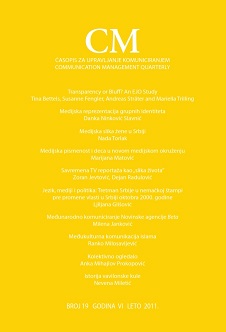Jezik, mediji i politika: Tretman Srbije u nemačkoj štampi pre promene vlasti u Srbiji oktobra 2000. godine
Language, Media and Politics: The Treatment of Serbia in the German Press in the Period Until and After the 5 October Overthrow in 2000
Author(s): Ljiljana GlišovićSubject(s): Media studies, Semiology, Political history, Social history, Philosophy of Language
Published by: Fakultet političkih nauka Univerziteta u Beogradu
Keywords: enemy image; stereotypes; discourse on the Balkans; the Cold War paradigm; the Clash of Civilisations paradigm; analogies; verbal means; paraverbal means;
Summary/Abstract: This paper presents the research results of the treatment of Serbia in the German press during the period 1987–2006 with reference to the relationship between language, media and politics. The research is divided into two periods in order to compare the negative, one-dimensional image of Serbia and the supposed construction of the image of Serbia as an enemy in the period until 2000, to the image after the overthrow in October 2000, and to establish, firstly, how the German press perceived the democratisation processes, secondly, if it came to the deconstruction of the enemy image of Serbia and, finally, if the enemy image of Serbia was reconstructed during the crisis period, confirming the thesis of the persistence of stereotypes and their activation in times of crisis. The main question of this research project is what journalistic means were used to construct the enemy image of Serbia. By content and discourse analysis of the news magazine Der Spiegel on one side, and the most influential German supraregional newspapers, so called quality papers, Frankfurter Allgemeine Zeitung (FAZ), Süddeutsche Zeitung (SZ), Frankfurter Rundschau (FR) and Tageszeitung (TAZ) on the other side, that enabled crosschecking of two reporting paradigms, it has been concluded that the enemy image of Serbia was constructed by overlapping thematic and formal levels on an ideological-political, anthropological-cultural and ethno-psychological basis. On the thematic level it was constructed by using stereotypes of Serbia within the discourse on the Balkans, polarised reporting, the Clash of Civilisations paradigm, non-differentiated use of the terms Serbia and Yugoslavia and analogies to Nazi Germany. On the formal level it was constructed using verbal means on the morphological, semantical and syntactic levels as well as paraverbal means like photos, caricatures and the relationship between photos and captions.
Journal: CM Komunikacija i mediji
- Issue Year: 6/2011
- Issue No: 19
- Page Range: 87-118
- Page Count: 32
- Language: Serbian

